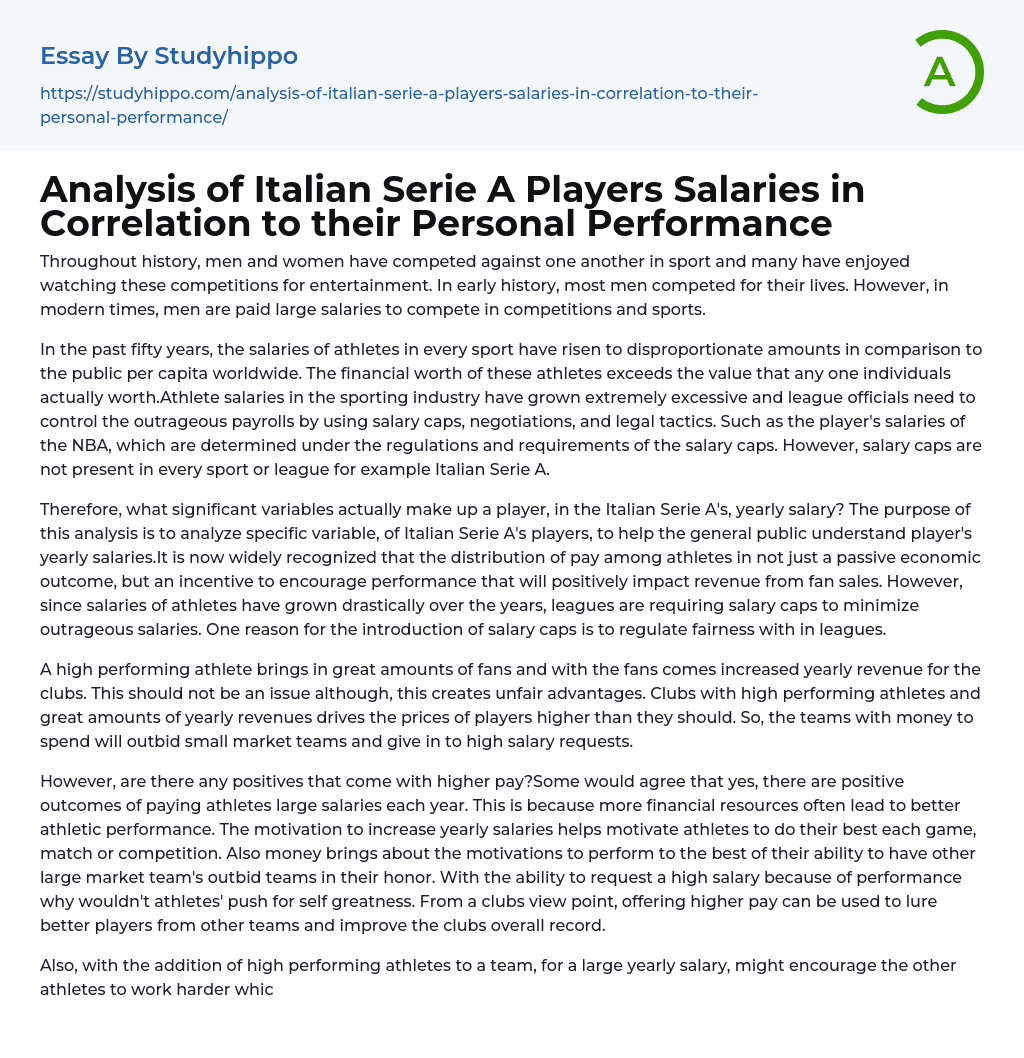Through the ages, sport has been a competitive arena for both genders, and has provided entertainment for many. While in the past men competed for survival, today's athletes are rewarded with significant salaries for their participation.
In the last five decades, athletes' salaries across various sports globally have significantly surged, often surpassing the per capita income of the public. These players' financial value goes beyond what any individual could possibly be worth. The inflated athlete pay has become a major concern in the sporting industry, necessitating league executives to take measures such as salary capping, negotiations, and legal strategies to curb exorbitant payroll costs. For instance, the NBA strictly regulates and sets player salaries according to salary cap rules. However, not every sport or league adheres to salary caps; this is evidenced by Italian Serie
...A.
The purpose of this analysis is to examine the key variables that contribute to a player's annual salary in the Italian Serie A League. It aims to assist the public in comprehending how a player's salary is determined. One widely accepted fact is that athlete pay distribution is not just a passive economic outcome, but also serves as an incentive to incentivize performance, which in turn increases revenue from fan sales. However, because athlete salaries have risen significantly over the years, leagues are imposing salary caps to reduce inflated salaries. One rationale for implementing salary caps is to promote fairness within leagues.
Athletes who perform at a high level attract large numbers of fans, resulting in increased annual revenue for their clubs. However, this can lead to unfair advantages since clubs with successful athletes and high yearly revenues drive playe
prices higher than necessary. Consequently, teams with financial resources will outbid small-market teams and concede to high salary demands.
Despite the debate on the benefits of higher pay for athletes, some argue that it can lead to better performance and positive outcomes. With increased financial resources, athletes are incentivized to put forth their best effort during games, matches, and competitions. Additionally, the prospect of earning a larger salary motivates them to strive for self-improvement and encourages other teams to outbid each other for their talents. Not only does higher pay benefit the individual athlete, but it can also aid clubs in attracting top-tier players and improving their overall record.
By paying high salaries to top-performing athletes, teams can inspire others to work harder and ultimately improve overall club performance. However, there are downsides to exorbitant salaries, with some leagues proposing salary caps as a solution for mounting club debts. This approach raises concerns about desperation in smaller markets that cannot compete with larger market clubs' bidding power. Consequently, small market teams may end up paying high athlete salaries despite their inability to afford them, leading to debt accumulation.
The president of Lazio, Claudio Lotito, has raised concerns about the impact of high salaries on athletes in clubs. He questions whether this is causing tension among team members and negatively affecting their performance. While there are debates surrounding the link between high salaries and athlete performance, the real issue lies in how these salaries are determined for the next season. These are important questions that drive research into professional Serie A Italian athlete's salaries.
The aim of this research is to examine the impact of various explanatory variables on
the dependent variable, the salaries of individual athletes. Specifically, the study investigates the significance of factors such as the number of games started, goals scored, position on field, club attendance, percentage of matches won, and age in determining athletes' salaries. The research sample comprises 57 randomly selected professional soccer players from the Italian Serie A league. The study assesses the effects of these variables during the 2006-2007 season on the players' salaries in 2007-2008. If a strong correlation exists between any of these variables and salaries, it will suggest that club management considers such factors closely when determining athletes' yearly salaries.
The study utilized data on player salaries for the 2007/2008 season from Calcio Serie A's database, which consisted of only 57 publicly available salaries. These salaries were earned by athletes who participated in the Italian Serie A league during the 2006/2007 season. To conduct their research, the investigator examined the individual statistics for each of these 57 players' performances throughout the 2006/2007 season on the Italian Serie A league's website. The dependent variable used in the regression analysis was presented as the natural logarithm of every player's total salary expressed in Euros.
Research revealed seven potential explanatory variables that could boost athletes' salaries. These factors encompassed the number of games started, goals and assists achieved, fouls committed, total club attendance, percentage of season wins (out of 38 games), and age during the season. Furthermore, three dummy variables were included in the regression model based on players' positions: defender, midfielder, and striker.
- Normal Distribution essays
- Probability Theory essays
- Variance essays
- Code of Ethics essays
- Conflict essays
- Dress Code essays
- Human Resources essays
- Organizational Behavior essays
- Performance essays
- Recruitment essays
- Safety essays
- Algebra essays
- Arithmetic essays
- Correlation essays
- Geometry essays
- Measurement essays
- Price Elasticity Of Demand essays
- Regression Analysis essays
- Statistics essays
- Career essays
- Career Path essays
- Homeless essays
- Labour Economics essays
- Occupational Safety And Health essays
- Pension essays
- Profession essays
- Salary essays
- Strike Action essays
- Wage essays
- Working Together essays
- Workplace essays




